Kimono Flea Market ICHIROYA's News Letter No.452
Hello from Japan! This is Kimono Flea Market ICHIROYA's News Letter No.452.
I have introduced the methods how to tell the material of kimono fabric. before.
I tried to find the definitive edition of the methods but could not find through research, so I decided to write this article which can be a good reference to be used for a long time. I hope this article can be useful!
To begin with, what is fiber and how they are made. The terms are quite confusing in Japanese, maybe that is the same in English or other language also..
Silk can be described as Shoken(genuine silk) or kinu(silk) but they are both silk.
Gosen and Koshoku---they are confusing, go means to mix, ko means to cross or join.
Gosen is artificial(synthetic) fiber and Koshoku is woven by multiple different material, such as silk and rayon together. Koshoku usually refers two different materials which are natural and artificial.
When we discuss what makes fiber, we need to know what makes the thread.
Thread is made of protein, cellulose or petroleum oil. If you know this, it is very easy!
What fiber is made from protein? Silk and wool of course! We must thank silkworms and sheep!
If you burn protein, what will happen? Just imagine a scene of explosion from comedies. Face becomes black and hair becomes fuzzy. That is how silk burns. It burns and extiguiqsh naturally and the ash is like black powder.
Here is the video of burning test of silk:
Just one thing should be added---silk with black dye often burns differently because of the black dye stuff.
Now when you burn wool, it looks like they look very similay to silk but smell is so different.
Wool smells so bad when it is burnt, so you can tell by the smell.
You can also tell the which one is wool by the texture. Wool has this slightly stinging texture, so you can touch carefully or try to check the feel by your cheeks. If the fabric has this stinging texture, it can be wool.
Silk, cotton and wool are made by short fiber but wool is the only one you feel this stinging texture.
Everything which are plants origin are cellulose, so cotton, asa(ramie) and jinken(rayon) are all in this group. When they are burnt, they keep burning to become ash.
Then what is the method to tell which is which? Cotton and asa(ramie) are made from short fiber but jinkn(it is made to be an alternative of silk) usually have long fiber. Cotton and asa(ramie) , they are alike but asa(ramie) tend to be smoother while cotton is more textured. Jinken is made from pulp, so you can consider jinken as paper(even though some jinken are so similar to silk and hard to tell the difference). When we see jinken by scope, they look so smooth and so even(and look artificial). You can just remember, these fabrics burn like a piece of paper.
So what you can do is to guess the fiber by its texture first- then do the burn test(if it is possible) and also check with microscope.
If burn text does not go well, then you can try to burn warp and weft separately.
By doing above experiment, you can tell most fabrics.
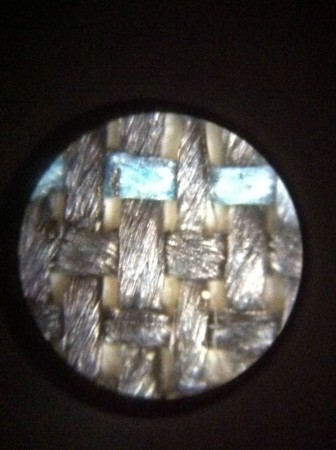
Noto jofu(asa) 50x
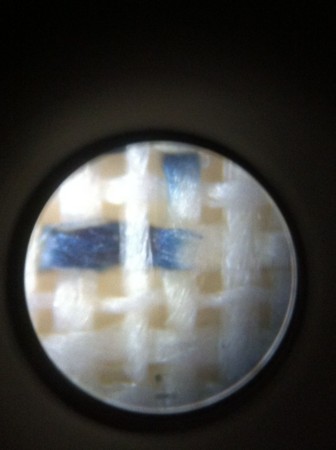
Ohmi jofu (asa) x50
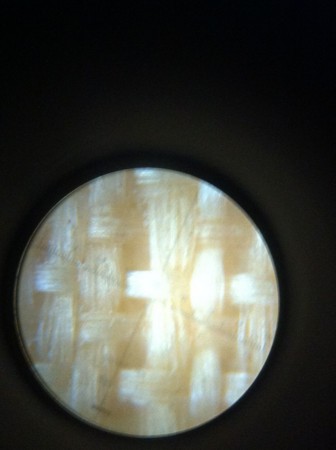
Nara sarashi (asa)x50
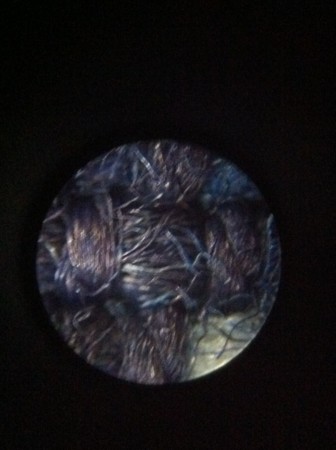
Yumhama kasuri (cotton) x50
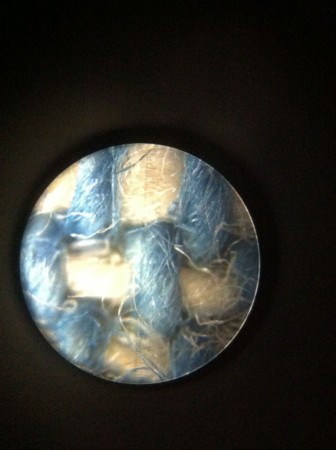
Mashiko momen(cotton) 50x

Bingo kasuri (cotton) 50X
The first three are asa(ramie) and next three are cotton.
I hope you can tell the difference of smoothness and textured surface.
However the case like the following photo is very confusing.
This is Yaeyama koufu and warp is cotton and weft is asa (ramie), actually.
It is hard to tell the difference even through the scope.
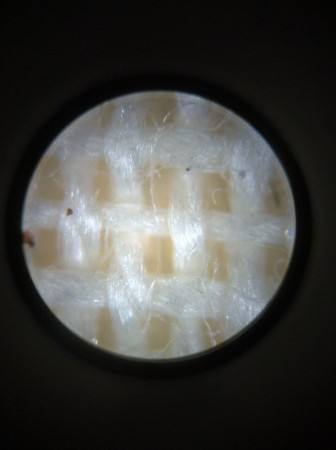
Here is an example of jinken(rayon- long fiber)
This is from antique ro kimono.

Jinken(rayon) 50X
I am sure you can see this very smooth and even threads.
Without scope also, it is easy to tell.
However, ther are fabrics like Yaeyama kofu(warp and weft are different). Also cottn woven with very thin thread are sometimes seen also. After all, the difference among asa(ramie) , cotton and jinken needs to be judged by comprehensive anaylysis using checkng the texture, touch, using scope and so on.
Finally, fabrics made of petroleum oil-polyester is known as a representative.Vinylon and acrylic are the same group too and they are just like pet bottle or plastic. When they are burnt, the melted part becomes hard.
Very well made polyester can deceive professional kimono dealers with a long career, but once it is burnt, it is obvious.
There are two other synthetic fiber used for kimono, they are not seen so often but they are acetate, and promix.
Acetate are often used for old children's kimono. They have gloss like silk. They are made of pulp and acetic acid, so we can often smell like vinegar.
Promix are called Gyunyu(milk) in kimono field. They are actually made from protain of milk and acrylic. The fabric has crisp and smooth texture just like Oshima but by burning test, you can tell the difference easily.
If you know all three composition(protein, cellulose and petroleum oil, then it will be easy to tell the difference of fabrics.
Here is one left-Bashofu(banana leaf fabric), very crisp touch!

We will be adding charming new arrivals also, we hope you enjoy checking our new arrivals too.
domo argato gozaimasu
with many kansha,
Ichiro & Yuka Wada
Kimono Flea Market ICHIROYA
http://www.ichiroya.com
e-mail: info@ichiroya.com
address: Asia-shoji Bldg.301
1841-1 Nishi 1 chome
Wakamatsu cho
Tondabayashi city
Osaka 584-0025 JAPAN
TEL&FAX ( international number ) -